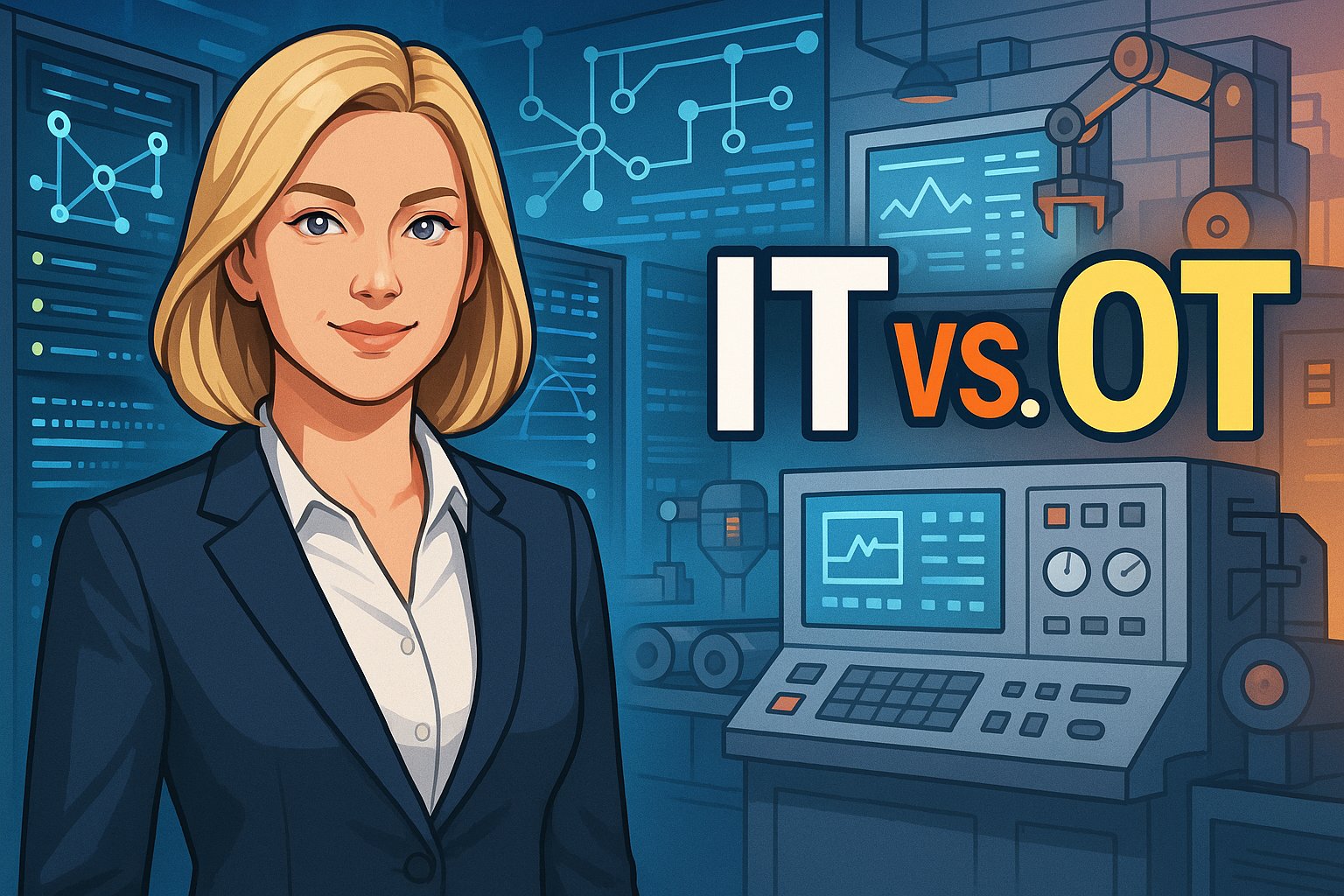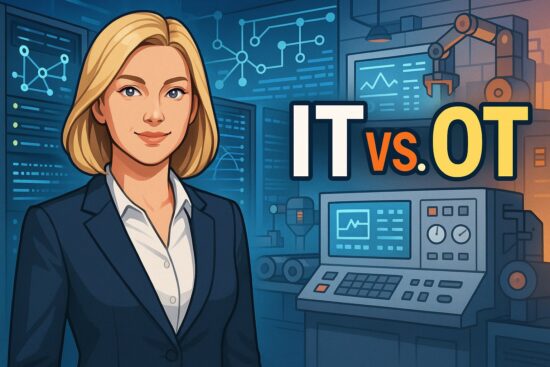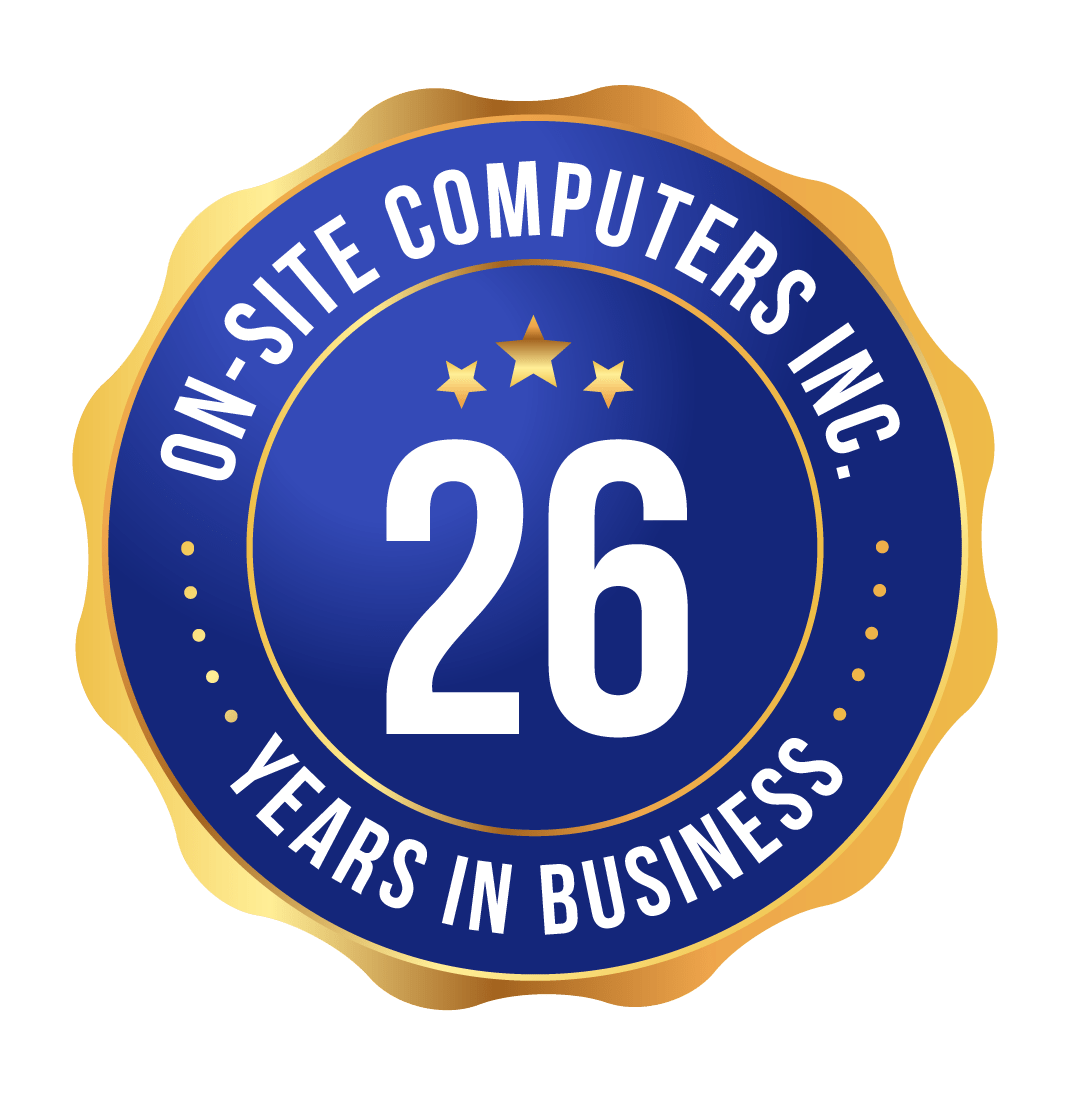How Does Operational Technology & Information Technology Differ? Key Distinctions for Modern Enterprises
Modern businesses rely on two distinct technological domains that serve fundamentally different purposes within the organization. While both are essential for operations, they handle separate aspects of your business infrastructure and have unique characteristics that set them apart.
Information Technology focuses on data processing, networking, and enterprise applications, while Operational Technology controls and monitors physical industrial processes and equipment. Understanding these differences between IT and OT becomes crucial as your organization navigates digital transformation and considers integrating these traditionally separate systems.
The convergence of IT and OT presents opportunities and challenges for your business. As industrial operations become more connected and data-driven, you need to understand how these technologies complement each other and what this means for your security, productivity, and operational efficiency moving forward.
Key Takeaways
- IT manages your organization’s data and information systems, while OT controls physical industrial processes and machinery.
- Your IT and OT networks have different security requirements, device lifespans, and operational priorities that require specialized approaches.
- Converging IT and OT systems can enhance productivity and reduce costs, but require careful planning for security and network integration.
Defining Operational Technology and Information Technology
Understanding the fundamental differences between these two technology domains requires examining their core purposes, applications, and the distinct environments where they operate. While IT manages data and business processes, OT controls physical systems and industrial equipment.
What Is Operational Technology (OT)?
Operational technology is hardware and software that monitors and controls devices, processes, and infrastructure in industrial settings. OT systems manage manufacturing equipment, power grids, and transportation networks.
OT focuses on making machines impact the physical world around you. These systems collect real-time data from sensors and use it to control industrial processes automatically.
Key OT Components:
- Industrial Control Systems (ICS)
- Supervisory Control and Data Acquisition (SCADA) systems
- Programmable Logic Controllers (PLCs)
- Computer Numerical Control (CNC) machines
- Robotics and automation equipment
OT devices tend to be purpose-built with specialized software and proprietary protocols. They operate continuously for decades without replacement and prioritize reliability over flexibility.
What Is Information Technology (IT)?
Information Technology encompasses computers, servers, networks, and software systems designed for data storage, processing, communication, and business operations management. Your organization relies on IT for email, databases, enterprise applications, and cloud services.
IT systems handle the informational backbone of your business. They process transactions, manage customer data, and support decision-making through analytics and reporting tools.
Core IT Elements:
- Enterprise servers and data centers
- Network infrastructure and cybersecurity
- Business applications and databases
- Cloud computing platforms
- End-user devices and support systems
IT devices are usually off-the-shelf, replaceable, and have a lifespan of 3-5 years. They run on common operating systems like Windows and Linux, making them easier to maintain and update.
Scope and Applications
You’ll encounter distinct applications for each technology type based on their fundamental purposes. IT is centered on your organization’s front-end informational activities, while OT focuses on back-end production machines.
IT Applications:
- Financial management and accounting systems
- Human resources and payroll processing
- Customer relationship management
- Business intelligence and analytics
OT Applications:
- Manufacturing process control
- Utility grid management
- Transportation system automation
- Building management systems
Your IT department maintains consistent policies across the organization and protects sensitive data. Meanwhile, your OT department focuses on production output, worker safety, and equipment uptime to maintain revenue streams.
Fundamental Differences Between OT and IT
Operational Technology and Information Technology serve distinct functions within modern organizations, with OT focusing on physical process control through PLCs and sensors. At the same time, IT manages business data through servers and ERP systems. These technologies operate in different environments with unique priorities for operational efficiency and data management.
Primary Objectives and Priorities
Your IT systems prioritize data confidentiality, integrity, and business continuity to support organizational operations. These systems focus on managing information flow, supporting business applications, and ensuring secure data management across your enterprise.
OT systems emphasize availability, safety, and real-time control of physical processes. Your operational technology must maintain continuous operation to prevent production shutdowns or safety incidents.
Response time requirements differ significantly between these domains. For most business applications, your IT systems can typically accommodate response times measured in seconds or minutes.
OT demands millisecond response times for critical industrial processes. Your programmable logic controllers must react instantly to sensor inputs to maintain safe and efficient operations.
Security priorities also diverge based on operational needs. While your IT infrastructure protects sensitive business data, your OT systems must balance security with operational availability.
Environments and Use Cases
Your IT systems operate primarily in office environments and data centers that support business functions like email, databases, and enterprise resource planning. These systems handle structured data processing and business intelligence applications.
OT functions in industrial environments, including manufacturing plants, power generation, and processing facilities. Your operational technology directly controls physical equipment and industrial processes.
Manufacturing environments utilize OT for production line control through PLCs that manage conveyor systems, robotic assembly, and quality control sensors. Your IT systems handle production scheduling and inventory management through ERP systems in these settings.
Energy sector applications demonstrate clear distinctions. Your OT monitors and controls turbines, generators, and distribution equipment while IT manages billing, customer service, and regulatory reporting.
Industrial networks support OT communications using specialized protocols optimized for real-time control. Your IT networks use standard protocols designed for data transmission and business connectivity.
Core System Components
Your IT infrastructure centers around servers, databases, networking equipment, and end-user devices. These components process business data, support applications, and enable organizational communication and collaboration.
Core IT components include enterprise servers running business applications, storage systems for data management, and network infrastructure connecting distributed locations. Your ERP systems integrate various business functions into unified platforms.
OT components focus on physical process control through programmable logic controllers, sensors, actuators, and human-machine interfaces. These systems directly interact with industrial equipment and manufacturing processes.
Your industrial networks connect PLCs, sensors, and control systems using protocols designed for deterministic communication. SCADA systems provide supervisory control and data acquisition for distributed operations.
Sensors and actuators form the foundation of your OT environment by monitoring physical parameters and executing control commands. PLCs process sensor inputs and generate control outputs to maintain optimal industrial processes.
Human-machine interfaces provide visualization and control capabilities for operators managing your industrial processes and equipment.

Technological Architecture and Network Structures
The foundational differences between OT and IT systems extend beyond their purposes, creating distinct technological ecosystems with unique network designs, communication methods, and device characteristics. These architectural variations directly impact how each system handles data, maintains security, and integrates with modern technologies.
OT Networks vs IT Networks
Your OT networks follow a hierarchical structure for real-time industrial control and monitoring. The network infrastructure differs significantly from traditional IT networks in several critical ways.
Network Architecture:
- OT Networks: Pyramid structure with multiple levels (field devices, control systems, supervisory systems)
- IT Networks: Flat or segmented architecture focused on data flow and user access
- Industrial IoT: Bridge between OT and IT through connected sensors and devices
Your OT network devices require specialized form factors and hardening capabilities. OT network devices come in smaller, modularized designs that mount on rails, walls, or within other equipment.
Environmental Requirements:
| OT Networks | IT Networks |
|---|---|
| Ruggedized for harsh conditions | Climate-controlled environments |
| Resistant to shock, vibration, chemicals | Standard office conditions |
| 24/7 operation without failure | Scheduled maintenance windows |
Communication Protocols and Standards
Your OT devices communicate through specialized industrial protocols that differ completely from standard IT networking. OT network devices support protocols not commonly used in traditional IT networks, creating unique integration challenges.
OT Protocol Examples:
- Modbus: Serial communication protocol for industrial devices
- Profinet: Real-time Ethernet-based protocol for automation
- Common Industrial Protocol (CIP): Network communication standard
Your IT networks rely on standard internet protocols and web-based APIs. Cloud computing integration becomes seamless through RESTful APIs and standard TCP/IP protocols.
Industrial Internet of Things (IIoT) devices bridge this gap by supporting both industrial protocols and modern connectivity standards. These devices enable your OT systems to communicate with cloud platforms while maintaining real-time control capabilities.
Device Types and Adaptability
Your OT devices fundamentally differ from IT devices in design philosophy and operational requirements. OT devices are purpose-built with specialized software and proprietary protocols, creating unique maintenance and security challenges.
Device Characteristics:
OT Devices:
- Purpose-built for specific industrial functions
- 10-20 year operational lifespans
- Proprietary operating systems and protocols
- Complex approval processes for updates
IT Devices:
- Off-the-shelf, easily replaceable components
- 3-5 year refresh cycles
- Common operating systems (Windows, Linux, iOS)
- Regular software updates and patches
Your IoT devices create hybrid categories combining industrial durability and modern connectivity. These devices support APIs for cloud integration while maintaining the reliability requirements of industrial environments.
IIoT Integration Benefits:
- Real-time data collection from industrial processes
- Cloud computing analytics for predictive maintenance
- Remote monitoring capabilities through secure APIs
- Standardized communication between OT and IT systems
Cybersecurity in OT and IT Environments
OT cybersecurity focuses on protecting critical infrastructure from attacks that could cause physical damage or operational shutdowns. IT cybersecurity emphasizes data protection through traditional security tools like firewalls and antivirus software while managing more frequent but potentially less catastrophic threats.
OT Security Challenges
Your OT environments face unique cybersecurity risks due to their isolated nature and critical functions. More than 90% of organizations operating OT systems experienced damaging security events within a two-year period.
Legacy System Vulnerabilities:
- Older industrial systems lack modern security features
- Proprietary protocols create blind spots for threat detection
- Limited ability to install traditional security tools
Patching Difficulties: You cannot easily update OT systems because patches require production shutdowns. Your critical infrastructure often operates with unpatched vulnerabilities that increase exploit risks.
Safety vs Security Trade-offs: Your primary concern is maintaining continuous operations rather than data confidentiality. Any malware or cyberattack that disrupts operations can cause immediate physical and financial damage across entire regions.
IT Security Practices
Your IT cybersecurity strategy relies on layered defence mechanisms and frequent updates. Traditional security tools form the foundation of protection for connected systems and data.
Standard Security Tools:
- Firewalls control network traffic and block unauthorized access
- Antivirus software detects and removes malware threats
- Intrusion detection systems monitor network activity
Zero Trust Architecture: You should implement zero trust principles that verify every user and device before granting access. This approach assumes no inherent trust within your network perimeter.
Regular Updates: Your IT systems require frequent patching through designated update cycles. Major vendors like Microsoft and Apple release regular security updates that you must install promptly to address emerging threats.
Data Protection Focus: Your IT cybersecurity prioritizes confidentiality and data integrity over operational continuity, allowing for planned downtime during security updates.
Unique Cybersecurity Risks
Your convergence of OT and IT systems creates new attack vectors that traditional security approaches cannot fully address. Cybercriminals increasingly target the intersection between these environments.
Cross-Domain Attacks: Attackers often penetrate IT networks first, then move laterally into OT systems. This progression exploits the growing connectivity between previously isolated operational environments.
IoT and IIoT Vulnerabilities: Your Industrial Internet of Things devices create additional entry points for cyberattacks. These connected sensors and controllers often lack robust security features while providing network access.
Nation-State Threats: Cyberattacks against OT systems rank among the top five global risks alongside climate change and geopolitical tensions. State-sponsored actors specifically target critical infrastructure for strategic advantage.
Hybrid Security Gaps: Your security teams may lack expertise in both domains, creating blind spots where OT and IT systems interact. This knowledge gap can leave vulnerabilities unaddressed during system integration.
Impact of IoT and IIoT on the IT/OT Divide
The Internet of Things and Industrial IoT fundamentally change how IT and OT systems interact, creating new integration opportunities while introducing complex connectivity challenges requiring careful management.
Role of the Internet of Things
IoT bridges traditional IT and OT environments by creating shared data pathways and communication protocols. Your manufacturing systems now generate seamless data between operational equipment and information management platforms.
The convergence enables real-time data sharing across previously isolated networks. Sensors embedded in operational equipment transmit performance metrics directly to IT-managed cloud platforms for analysis.
This connectivity transforms how you monitor and control industrial processes. IoT projects focus on device onboarding and data aggregation into centralized systems that IT and OT teams can access.
Your operational technology now communicates with enterprise resource planning systems, customer relationship management platforms, and business intelligence tools. This integration provides comprehensive visibility into production workflows and equipment performance.
Industrial IoT and Industry 4.0
Industrial IoT drives the transformation toward Industry 4.0 by connecting manufacturing equipment, sensors, and control systems to digital networks. Your production facilities gain intelligent automation capabilities through this connectivity.
Complex machines now integrate with network sensors to enable predictive maintenance and automated quality control. Manufacturing execution systems communicate directly with programmable logic controllers and distributed control systems.
The integration creates smart manufacturing environments where:
- Equipment monitors its own performance
- Production lines adjust automatically to demand changes
- Quality control systems trigger immediate corrections
- Inventory management updates in real-time
The historic differences between IT and OT are dissolving as Industry 4.0 technologies require seamless data flow between operational and information systems.
New Connectivity and Integration Challenges
Increased connectivity between IT and OT systems creates significant cybersecurity vulnerabilities that require specialized protection strategies. The potential for cyber attacks on both information technology and operational technology has grown substantially.
Your operational networks, traditionally designed for reliability rather than security, now face internet-based threats. Legacy OT systems often lack modern security features, creating entry points for malicious actors.
Key integration challenges include:
| Challenge | IT Impact | OT Impact |
|---|---|---|
| Protocol Differences | Network compatibility issues | Equipment communication failures |
| Security Standards | Data breach risks | Production system vulnerabilities |
| Update Cycles | Frequent software updates | Minimal system changes |
Organizations must overcome numerous challenges, including network architecture redesign, staff training, and security protocol implementation. Your teams need new skills to manage hybrid IT/OT environments effectively.
IT/OT Convergence and Integration Strategies
The merging of information and operational technology systems requires strategic planning driven by business needs and technological capabilities. When implementing proper governance frameworks, organizations achieve significant operational improvements through enhanced automation, real-time data visibility, and reduced downtime.
Drivers of IT/OT Integration
Your organization faces mounting pressure to integrate IT and OT systems as 65% of industrial companies actively pursue these initiatives. Digital transformation demands push you toward unified systems that break down traditional silos.
Primary integration drivers include:
- Operational Efficiency: You need real-time visibility into production processes and equipment performance
- Cost Reduction: Integration eliminates duplicate systems and reduces maintenance overhead
- Competitive Advantage: Modern customers expect faster delivery and customization capabilities
- Regulatory Compliance: Industry standards increasingly require integrated monitoring and reporting
Your equipment generates massive amounts of data that remains isolated in OT systems. IT/OT convergence enables real-time data exchange between operational floors and business systems.
You can leverage this integration to predict equipment failures before they occur. Advanced analytics identify patterns that signal impending breakdowns, allowing preventive maintenance scheduling.
Benefits and Opportunities
Your integrated IT/OT environment delivers measurable improvements across multiple operational areas. Enhanced decision-making capabilities emerge from accurate, timely data flowing between systems.
Key operational benefits:
| Benefit Area | Impact |
|---|---|
| Unplanned Downtime | 20-30% reduction through predictive maintenance |
| Data Processing | Real-time analytics enable immediate response |
| Automation | Streamlined workflows reduce manual intervention |
| Real-time Monitoring | Complete visibility across production systems |
You gain the ability to automate complex processes that previously required manual coordination. Smart manufacturing systems adjust production parameters automatically based on quality metrics and demand fluctuations.
Your maintenance teams receive alerts before equipment reaches critical failure points. This proactive approach minimizes unexpected shutdowns and extends asset lifecycles.
New service models and pricing strategies become possible when you can monitor product performance in real-time. You can offer outcome-based contracts and performance guarantees to customers.
Collaboration and Governance
For successful integration, your IT and OT teams must establish clear communication channels and shared responsibilities. Traditional organizational boundaries create barriers that require structured collaboration frameworks.
Essential governance elements:
- Cross-functional Teams: Include IT, OT, security, and business stakeholders in planning
- Standardized Protocols: Establish common data formats and communication standards
- Security Frameworks: Implement unified cybersecurity policies across both domains
- Change Management: Create processes for system updates and modifications
You need dedicated project management to coordinate between departments with different priorities and timelines. IT teams focus on data security and network stability, while OT teams prioritize system availability and safety.
Your security posture requires comprehensive planning as 78% of organizations encounter significant security challenges during integration. Establish network segmentation and access controls that protect critical operational systems.
Regular assessment cycles help you identify integration gaps and optimization opportunities. Monthly reviews between IT and OT leadership ensure priorities and resource allocation alignment.
Best Practices and Future Trends
Organizations must implement robust security frameworks while adapting to rapidly evolving technologies that blur the lines between operational and information systems. Network isolation strategies, systematic update protocols, and emerging automation technologies form the foundation of modern OT-IT convergence.
Network Segmentation and Access Control
Network segmentation creates physical and logical barriers between OT and IT environments. You should establish multiple security zones with firewalls controlling traffic flow between industrial control systems and corporate networks.
Critical Segmentation Strategies:
- DMZ Implementation: Deploy demilitarized zones between OT and IT networks
- VLAN Separation: Use virtual LANs to isolate critical operational systems
- Zero Trust Architecture: Verify every connection before granting access
Access control mechanisms must authenticate users before they interact with operational systems. Multi-factor authentication becomes essential for personnel accessing both domains.
Role-based permissions ensure employees only access systems necessary for their functions. You should regularly audit user privileges and remove unnecessary access rights.
HTTPS protocols secure data transmission between OT and IT systems. API gateways provide controlled interfaces while maintaining data confidentiality during cross-domain communications.
Industrial networks require specialized access controls that account for legacy equipment limitations. Many older OT systems lack modern authentication capabilities.
Patch Management and System Updates
OT systems traditionally operate on extended lifecycles with infrequent updates. You must balance security patches with operational continuity requirements.
Update Scheduling Framework:
| System Type | Update Frequency | Maintenance Window |
|---|---|---|
| Critical OT | Quarterly | Planned shutdowns |
| Standard OT | Semi-annually | Off-peak hours |
| IT Systems | Monthly | After-hours |
Testing patches in isolated environments prevents operational disruptions. You should maintain separate test networks that mirror production OT configurations.
Legacy systems present unique challenges since vendors may no longer provide security updates. Virtual patching through network security appliances can protect outdated equipment.
Change management processes must coordinate between OT and IT teams. Documentation requirements differ significantly between operational and information technology domains.
Machine learning algorithms can predict optimal maintenance windows based on operational patterns. These systems analyze historical data to minimize production impact during updates.
Emerging Technologies and Evolution
Industrial Internet of Things generates unprecedented operational data volumes for analysis and optimization. Connected sensors throughout manufacturing facilities provide real-time performance metrics.
Edge computing processes OT data locally before transmitting to central IT systems. This reduces latency while maintaining operational responsiveness requirements.
Cloud integration enables advanced analytics while preserving on-premises control systems. Hybrid architectures balance connectivity benefits with security concerns.
Machine learning applications predict equipment failures through pattern recognition in operational data. Predictive maintenance systems reduce unplanned downtime significantly.
Digital twins create virtual replicas of physical systems for simulation and testing. These models enable scenario planning without disrupting actual operations.
API standardization facilitates seamless data exchange between OT devices and IT applications. RESTful interfaces provide consistent communication protocols across different vendor systems.
Cybersecurity convergence addresses threats targeting both operational and information assets. Unified security platforms monitor cross-domain activities for comprehensive threat detection.






